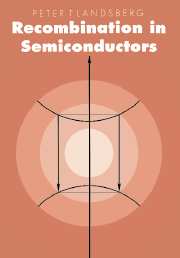Book contents
- Frontmatter
- Contents
- List of main symbols
- Note on units
- Introduction
- 1 Semiconductor statistics
- 2 Recombination statistics
- 3 Auger effects and impact ionization (mainly for bands)
- 4 Radiative recombination (mainly for bands)
- 5 Defects
- 6 Multiphonon recombination
- 7 Recombination in low-dimensional semiconductor structures
- Appendix A The delta function (section 3.2)
- Appendix B Useful identities arising from the periodic boundary condition (section 3.4)
- Appendix C Fourier expansions (section 3.4)
- Appendix D The effective mass sum rule and the dynamics of Bloch electrons (section 3.6)
- Appendix E Diagonalization and Jacobian for the threshold energy and impact ionization calculation (section 3.5.7)
- Appendix F The saddle-point method, and the method of stationary phase (section 6.3)
- Appendix G Evaluation of the integral (6.6.12) (section 6.6)
- References
- Index of names
- Index of topics, concepts and materials
2 - Recombination statistics
Published online by Cambridge University Press: 22 September 2009
- Frontmatter
- Contents
- List of main symbols
- Note on units
- Introduction
- 1 Semiconductor statistics
- 2 Recombination statistics
- 3 Auger effects and impact ionization (mainly for bands)
- 4 Radiative recombination (mainly for bands)
- 5 Defects
- 6 Multiphonon recombination
- 7 Recombination in low-dimensional semiconductor structures
- Appendix A The delta function (section 3.2)
- Appendix B Useful identities arising from the periodic boundary condition (section 3.4)
- Appendix C Fourier expansions (section 3.4)
- Appendix D The effective mass sum rule and the dynamics of Bloch electrons (section 3.6)
- Appendix E Diagonalization and Jacobian for the threshold energy and impact ionization calculation (section 3.5.7)
- Appendix F The saddle-point method, and the method of stationary phase (section 6.3)
- Appendix G Evaluation of the integral (6.6.12) (section 6.6)
- References
- Index of names
- Index of topics, concepts and materials
Summary
Basic assumptions for recombination statistics
General orientation
A transition in which an electron jumps from a high energy to a low energy state which is located in a different group of levels is called recombination. One can think of the electron vacancy in the lower states as a trapped hole. The transition is then an electron–hole recombination, in which both ‘particles’ disappear and energy is released, for example in the form of photons or phonons. The different groups of levels are normally different energy bands or valleys in k-space or different groups of localized states. Transitions within a band are not normally considered as recombination events as they take place very quickly.
Figure 2.1.1 gives examples of recombination transitions. As in chemical kinetics, the rate per unit volume is regarded as proportional to the frequency of collision (which is itself proportional to the appropriate product of concentrations) and a recombination coefficient. In part (a) of the figure, for example, the frequency of collision is np and the coefficient, Bs say, has the dimension [L3T−1]. The other recombination rate expressions are obtained similarly, v0 and v1 being the concentration of empty and occupied defect centers. In the fourth process, for example, one may suppose that an electron recombines with a hole trapped on a defect. In writing down the rates one must remember that full states in the valence band and unoccupied states in the conduction band ‘do not count’. There are usually enough of them so that they do not affect the rate.
- Type
- Chapter
- Information
- Recombination in Semiconductors , pp. 102 - 219Publisher: Cambridge University PressPrint publication year: 1992

